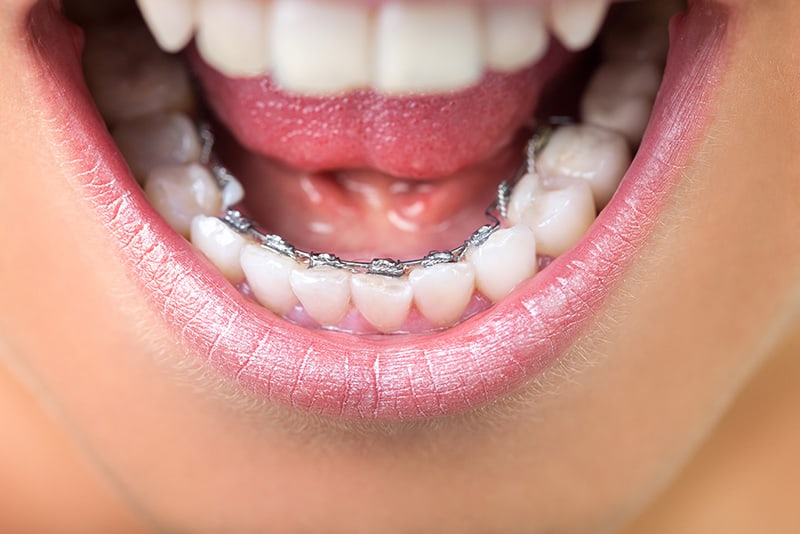Comparison between metal braces, clear braces and clear aligners (e.g. Invisalign®)
- Posted: 20 Jul 2021 | Authored by: Dr. Tan Wee Han | Reviewed by: Dr. Arlene Khaw Bee Hong
A common question that we get regarding braces is: what is the best type of braces?
Well, the short answer to that is, it depends. The most suitable braces for you would be one which fits your budget, personal preference, job (e.g. some airlines do not allow visible braces for flight attendants), etc.
Below is an overview of different types of braces:

In this blog, we will only be comparing metal and clear braces with clear aligners. Plates (removable and functional appliances) are normally reserved for simpler cases and will be discussed in another blog.

Metal braces

Brackets are braces attachments which are glued to the teeth. Brackets can be made of metal (e.g. stainless steel, titanium) or clear materials (e.g. plastic, ceramic or composite).
Stainless steel is the most common material for metal braces. Titanium brackets can be used for patients who are allergic to stainless steel brackets.
Metal braces can be fitted in front (labial), or behind the teeth (lingual).
Lingual braces are invisible but because they are fitted behind the teeth, they tend to cause more discomfort to the tongue. Lingual braces are technically more challenging to manage for the dentist/ Orthodontist.

Lingual Braces
Clear braces

As the name suggests, clear braces are tooth-coloured which makes them less conspicuous than metal braces. Earliest version (1970s) of clear brackets was made of plastic but had problems like staining, poor strength, poor stability and high friction1.
Currently, ceramic brackets are the main option for clear braces. However, ceramic brackets are not suitable for patients with deep bite as the brackets can cause wear to the opposing teeth.
Newer clear brackets are made of composite which is the same material used for tooth fillings. These brackets are highly aesthetic.
Clear braces are very popular among patients here at Tan Dental Surgery.
Clear aligners (e.g. Invisalign®)

Clear aligners are transparent plastics which cover the teeth. They are almost invisible when worn and look like vacuum-formed retainers. In fact, the material used to produce clear aligners is almost similar to retainers and the fabrication process is also similar. One could even say clear aligners are “active” forms of retainers which can move teeth.
Invisalign® was the first commercial clear aligner system introduced in 1998 by Align Technology (Santa Clara, California). The idea was to use a series of clear plastics to move teeth little by little. Each aligner has to be worn for 2 weeks and after that, the patient proceeds with the next aligner in sequence.
More affordable brands of clear aligners are starting to become available now. The differences between the different brands are the material used, cost and manufacturing location.
Clear aligners are gaining popularity now due to the invisible appearance and increased comfort compared to metal/clear braces. And because the aligners can be removed, tooth brushing is made easier.
However, disadvantages with clear aligners include possible longer total treatment time than normal braces2 and difficulty in moving teeth in certain directions.
Table of comparison between metal braces, clear braces and clear aligners
 Metal braces
Metal braces
|
 Clear braces
Clear braces
|
 Clear aligners
Clear aligners
|
|
|---|---|---|---|
| Material |
Stainless steel Titanium |
Plastic Ceramic Composite |
Elastic thermoplastic material |
| Durability | Very strong | Brittle and bulkier than metal brackets | Aligners can break if not handled well |
| Appearance | Silver-coloured | Tooth-coloured | Transparent |
| Comfort | Might cause discomfort | Might cause discomfort | More comfortable |
| Oral hygiene care | More difficult to clean | More difficult to clean | Easier to clean teeth as aligners are removable |
| Types of cases | Suitable for all cases | Not suitable for deep bite cases | More suitable for mild to moderate cases |
| Cost | $ ($$$ for lingual braces) | $$ | $$$ |
| Compliance | No compliance with wear required as brackets are fixed | No compliance with wear required as brackets are fixed | Compliance with aligner wear required (20-22 hours per day) |

In summary, if you are on a tight budget, then metal braces, specifically labial ones (fitted in front) is the most cost-effective option.
If you do not like the “metal mouth” look and budget is not a concern, then your options are clear braces, lingual braces or clear aligners. Of these 3 options, clear braces are the cheapest. Clear aligners are definitely more comfortable than clear and lingual braces. However, clear aligners might not be suitable for cases that are more complex.
We offer all types of braces at Tan Dental Surgery. In our opinion, the metal and clear braces are still the best options for the majority of patients as they are more affordable and produce predictable results.
If you are thinking of having braces, be sure to check out our other braces related posts here.
Did you know?
Prior to the 1970s, brackets were welded to metal bands/rings. The bands were custom-made and fitted around each tooth individually (see below). The fitting process was arduous, time-consuming and uncomfortable. In fact, the entire process could take an entire day!

Updated: 20 Sept 2021




